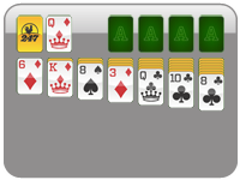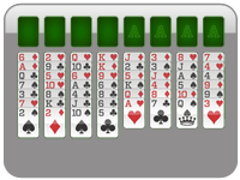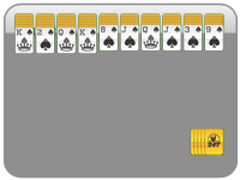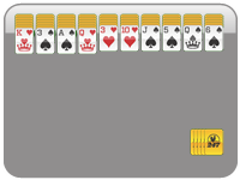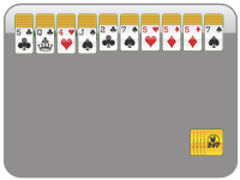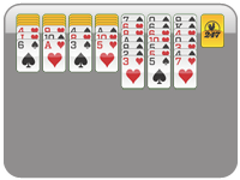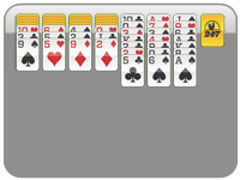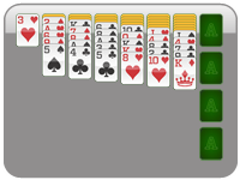Spades Strategy for Beginners: From First Bid to Final Trick

Spades looks simple: bid your tricks, then win them, but winning consistently takes a plan before the first card hits the table. This beginner-friendly spades card game strategy guide walks you through every phase: pre-bid evaluation, safe, honest bidding, protecting or attacking Nil, and smart bag control.
You'll learn when to cash side-suit aces, when to break spades, and how to switch between offense and defense as the score and distribution change. We'll finish with endgame tactics that seal sets rather than give them back. Start here and turn steady choices into steady wins.
Spades in 60 Seconds (Flow, Not Every Rule)

Spades is a partnership trick-taking game where each side predicts the number of tricks they'll win; make your bid to score, miss it, and you're set. Spades are always trump, and you typically can't lead them until they're broken. Think of each hand as five phases: evaluate, bid, play offense/defense, manage bags, and close the set.
- Objective: hit your team's bid; overtricks ("bags") accumulate penalties.
- Trump: Spades beat every non-spade; they're led freely after someone uses one on another suit.
- Flow: evaluate your winners, set a safe bid, execute, track bags, and close cleanly.
Spades Strategy for Every Phase

Pre-Bid Evaluation: Count Potential Winners (and Losers)
A strong bid begins before anyone speaks. Scan your hand for sure winners and likely trouble. The more realistic your count, the fewer sets you'll take later.
- High cards by suit: Aces are near locks on early leads; Kings/Queens depend on position.
- Length & voids: Long side suits can grow tricks after honors fall; voids create ruff chances.
- Trump strength: Total spades + top honors (A/K/Q/J) signal control or caution.
- Positional notes: Bidding last lets you adjust to the table; sitting after a big bidder helps on defense.
Bidding Basics: Safe, Solid, and Honest
Good bidding is measured, not lucky. Count sure winners and, at most, one potential if length and position support it. Then round down.
- Sure winners + 1: Only add one "maybe" if you have length or entries.
- Avoid overbids: Being set by one trick erases lots of good play; beginners should round down.
- Partnership target: Aim for a combined number you can actually make; communicate intent by being conservative or assertive (no table talk).
- Sandbags: Have a plan to avoid 10 bags (often −100). Take extras on purpose only if the scoreboard says it's safe.
Nil & Blind Nil: When to Use Them (and When Not To)
Nil is powerful but shape-dependent. Bid 0 only when your hand truly cooperates, and only when your partner can help.
- Good Nil shapes: Many low cards, few spades, and a distribution that lets you duck under honors.
- Protecting Nil: Partner should overtrump threats, draw out danger cards, and lead through opponents' strengths.
- Blind Nil: A comeback lever when far behind and bidding blind is allowed; it's a high-risk, table-dependent move.
- Skip Nil: If you see 2–3 likely winners (e.g., Ace of spades or stray aces), take a small bid instead.
Opening Leads: Set the Tone
Your first lead frames the hand. Cash sure winners before they vanish and avoid waking up to enemy trumps without a plan.
- Cash side-suit Aces early before they get ruffed.
- From length without the Ace: Lead second-high or low to test where the honor sits.
- When holding strong spades, don't lead trump first, cash side winners, then break when it helps you.
- If your partner bids high, choose leads that pull enemy winners or establish the partner's suit.
Following Suit: Small Edges That Add Up
Once the lead is out, even tiny technique changes can have an impact on the outcomes. Don't waste honors; do cover when it saves a vital trick.
- Second-hand low (usually) to conserve power, unless winning prevents a bigger loss.
- Third hand high (often) to secure the trick, especially guarding a partner's Nil.
- Track voids: If someone shows out, expect trump next time; bait it on your terms.
Trump Management: Breaking and Pulling Spades
Treat spades like the table's brakes. Time their use to either protect your plan or disrupt theirs.
- Break trump to stop cross-ruffs or to protect a Nil.
- Pull spades when your side has more/stronger trumps and gains from control.
- Don't break if you still need to cash side winners first.
- Time pulls to deny entries into an opponent's long suit.
Counting Cards (Without Looking Like a Magician)
You don't need a perfect memory, just a light ledger that stays current.
- Track spades (there are 13): how many are out, who is void.
- Note A/K/Q that have fallen in side suits to foresee promoted winners.
- Keep it light: a few anchors like "8 spades seen; West is out of hearts" are enough.
Offense vs. Defense: Switching Gears Mid-Hand
Great teams switch modes as the board changes. Know what to emphasize.
- On offense (your team bid big): cash near-locks early, create entries for partner's winners, and pull trump when you hold the edge.
- On defense (they bid big or Nil): lead through strength to force high cards, avoid feeding ruffs, and against Nil, force wins onto the Nil player by leading their weak suits.
Bag Management: The Quiet Way You Lose (or Win)
Bags seem harmless until they aren't. Win them on purpose; otherwise, avoid them.
- Know your current bag total; nearing 10 means it's time to stop taking freebies.
- Bleed bags safely once your bid is secure and duck tricks you don't need.
- Weaponize bags: If opponents hover at 8–9, tempt them with extra bags by using safe-looking leads.
Setting Opponents: Turning Pressure into Points
Once you spot a stretched bid, press where it hurts and starve their access to winners.
- Target fragile numbers (e.g., a jump from 4 to 6).
- Attack their weakest suit early to expose a lack of cover.
- Deny entries to long suits and make them spend trump on low-value tricks.
Endgame: Closing Without Giving It Back
The last few tricks swing scores. Recount what each side still needs and manage risk.
- Recount needs vs. affordables: who still needs how many tricks?
- If ahead with bags: duck harmless tricks to avoid penalties.
- If behind: manufacture one extra, create a ruff, or promote a low trump with smart leads.
Partner Play: Coordination Without Table Talk
Spades forbids table talk, so you communicate through bids and the way you play tricks.
- Show intent via bids and lines of play (e.g., leading partner's suit, returning strong leads).
- When your partner shows strength, return that suit to open their winners.
- Nil protection first: as the protector, you take risks, so the Nil can keep ducking.
Scoreboard Awareness: Strategy Changes with the Numbers
Your plan at 0–0 shouldn't be your plan at 481–472. Thoroughly understand the scoring in spades and adjust to the situation accordingly.
- Early game: Play solid; avoid sets and bag spikes.
- Mid-game: Aim at their bag count or press if you're behind.
- Late game: Bid to the win condition, sometimes a make beats chasing flashy overtricks.
Turn today's tips into wins: start a session
Practice makes perfect, so launch 247Games Spades and run a themed mini-session. Game one is about nil awareness. Would your hand support Nil or protect a partner? Make the conservative call and execute.
Make game two about trump management. Pull spades only when your side benefits; otherwise, cash side winners first. Finish with a quick endgame recount to avoid freebies. Jot one takeaway per game and apply it to your next shuffle. Go to 247games now!
Solitaire Games
More Solitaire Games
More Games
Solitaire News
Disclaimer
DISCLAIMER: The games on this website are using PLAY (fake) money. No payouts will be awarded, there are no "winnings", as all games represented by 247 Games LLC are free to play. Play strictly for fun.

